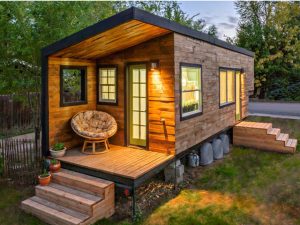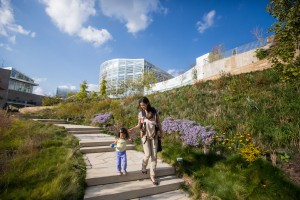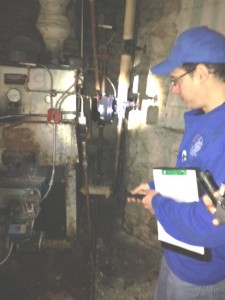Tag: residential
November 5, 2020
GreenHomeNYC Virtual Tour: Can We Fix Everything? Bring Sustainability Home
Join Sandra Goldmark, Barnard professor and author of Fixation: How to Have Stuff without Breaking the Planet, for a quarantine-tour of her home. Here’s an excerpt from the book: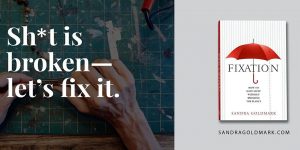 “We know that as humans, we need stuff; we are deeply entangled with it. And we know that stuff can be a good thing, or at least that some stuff is better than other stuff. The caveat is that, as with food, there can be too much of a good thing. The surfeit of unhealthy stuff calories in our lives doesn’t only create clutter, or pollution. It helps to define who we are, as individuals and as a society: our stuff tells a story. As a result of a variety of influences, both external and internal, our shared story has become one of excess and of being overwhelmed, or heedlessly consuming and exploiting; but we are beginning to find ways out of all the mess and toward a simpler narrative, a healthier “stuff culture” that tells a story of balance and joy.
By learning to see our stuff not as passive, voiceless objects but as an active, contributing part of the story, we can consciously use our stuff to change the meaning of the tales we live. In our homes, we each design a real-life theatre set around ourselves, and we act out our lives on our little stage every day. We may be living a narrative of clutter or hoarding but want to shift to one of tidiness and joy. Or we may have an apartment that looks perfectly good, but where the practices of making our clothes and furniture are toxic to people and the planet alike. By learning how our stuff can shape our world, onstage and off, we can begin to design and live a better story, individually and collectively.”
“We know that as humans, we need stuff; we are deeply entangled with it. And we know that stuff can be a good thing, or at least that some stuff is better than other stuff. The caveat is that, as with food, there can be too much of a good thing. The surfeit of unhealthy stuff calories in our lives doesn’t only create clutter, or pollution. It helps to define who we are, as individuals and as a society: our stuff tells a story. As a result of a variety of influences, both external and internal, our shared story has become one of excess and of being overwhelmed, or heedlessly consuming and exploiting; but we are beginning to find ways out of all the mess and toward a simpler narrative, a healthier “stuff culture” that tells a story of balance and joy.
By learning to see our stuff not as passive, voiceless objects but as an active, contributing part of the story, we can consciously use our stuff to change the meaning of the tales we live. In our homes, we each design a real-life theatre set around ourselves, and we act out our lives on our little stage every day. We may be living a narrative of clutter or hoarding but want to shift to one of tidiness and joy. Or we may have an apartment that looks perfectly good, but where the practices of making our clothes and furniture are toxic to people and the planet alike. By learning how our stuff can shape our world, onstage and off, we can begin to design and live a better story, individually and collectively.”
Date: Thursday, November 12, 2020
Time: 6:30 PM – 8:00 PM EST
Location: Online You can find more information and register here.November 28, 2017
November Green Building Tour Recap: Building Towards Resilience
by Brigitta Berze It’s been five years since Hurricane Sandy hit the East Coast, leaving a trail of destruction in the New York area. During the “Building Towards Resilience” Green Building Tours event, Henry Gifford of Chris Benedict R.A., led a tour through 327 and 334 East 8th Street – two Lower East Side buildings that were affected by the hurricane – providing a firsthand look at renovations that were made in the aftermath of the natural disaster.
It’s been five years since Hurricane Sandy hit the East Coast, leaving a trail of destruction in the New York area. During the “Building Towards Resilience” Green Building Tours event, Henry Gifford of Chris Benedict R.A., led a tour through 327 and 334 East 8th Street – two Lower East Side buildings that were affected by the hurricane – providing a firsthand look at renovations that were made in the aftermath of the natural disaster.
The tour began in the noisy basement of 334 East 8th Street, with a description of the damage after Hurricane Sandy, including the conditions that the workers had to endure. The elevator in this building is not counteracted by weights to lift the elevator car, but instead uses oil mixed with other chemicals in a hydraulic elevator machine. As the water rose to about six feet above the basement floor, the oil and chemicals mixed with the flood waters, creating a hazardous condition for workers. The slippery mix of oil, water and sewage caused the superintendant to get a foot infection that landed him in the hospital for three days.
(more…)September Forum Recap: Spotlight on Hudson Yards
by Jennifer Urrutia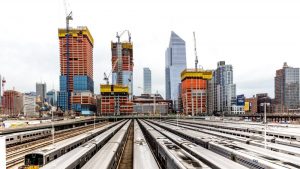
Photo source: ny.curbed.com
June 5, 2017
June Tour: 475 High Performance Building Supply House and Demo
GreenHomeNYC INVITES YOU TO
DISCOVER HIGH PERFORMANCE BUILDING MATERIALS IN BROOKLYN
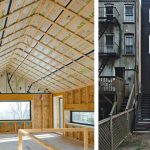 Join us to learn how leading architects and developers achieve rigorous Passive House standards here in the City. We will tour the 475 High Performance Building Supply warehouse in Brooklyn to learn about the latest products that can lead to 90% reductions in heating and cooling energy usage. Founded and run by architects, 475 provides building knowledge and components to help professionals meet the international Passive House building standards. Guests will be treated to an interactive presentation on green building materials and diagnostic testing that improve air sealing, ventilation, fenestration, thermal insulation, and overall performance. This is a hands-on experience with cutting edge green building materials. It’s the next best thing to being in the Paris Agreement!
Join us to learn how leading architects and developers achieve rigorous Passive House standards here in the City. We will tour the 475 High Performance Building Supply warehouse in Brooklyn to learn about the latest products that can lead to 90% reductions in heating and cooling energy usage. Founded and run by architects, 475 provides building knowledge and components to help professionals meet the international Passive House building standards. Guests will be treated to an interactive presentation on green building materials and diagnostic testing that improve air sealing, ventilation, fenestration, thermal insulation, and overall performance. This is a hands-on experience with cutting edge green building materials. It’s the next best thing to being in the Paris Agreement!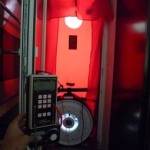 After the tour guests are encouraged to join GreenHomeNYC for networking drinks at nearby Threes Brewing
After the tour guests are encouraged to join GreenHomeNYC for networking drinks at nearby Threes Brewing
March 1, 2017
Monthly Forum Recap: Everyday People and Sustainability
by Theresa Baker If you’re trying to make more sustainable choices in your daily life, the GreenHomeNYC February Forum offered plenty of options. The evening featured four speakers who spoke passionately about ways that “everyday people” in New York City can improve their quality of life, save energy and live more sustainably. Simple Steps for Everyone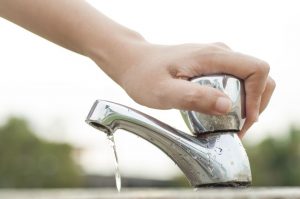 Carmel Pratt, a Sustainability Consultant for Steven Winter Associates, spoke on the top ten ways to save energy in your apartment or home. Pratt pointed out a stunning statistic – the average American uses 140-170 gallons of water per day through choices they make in the kitchen, bathroom and laundry. By simply not running water when washing dishes, limiting shower time, and using cold water instead of hot when doing laundry, residents can significantly reduce this usage. (more…)
Carmel Pratt, a Sustainability Consultant for Steven Winter Associates, spoke on the top ten ways to save energy in your apartment or home. Pratt pointed out a stunning statistic – the average American uses 140-170 gallons of water per day through choices they make in the kitchen, bathroom and laundry. By simply not running water when washing dishes, limiting shower time, and using cold water instead of hot when doing laundry, residents can significantly reduce this usage. (more…)
June 30, 2016
June Forum Recap: Community Solar Comes to New York State
by Pamela Berns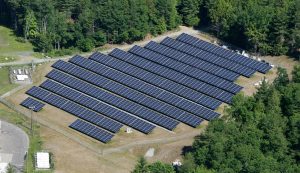 According to Dennis Phayre of EnterSolar, even if we utilized all currently available sources, we’d only have about 100 years of energy left on the planet. But New York State isn’t waiting one more second to embark on innovative partnerships that will not only extend that timeframe but also significantly reduce the State’s carbon footprint.
On June 15, at the host offices of the New York State Energy Research & Development Authority (NYSERDA), GreenHomeNYC introduced three key players in these new collaborations for an instructive and exciting program about community solar. Community solar brings together customers, utilities, solar companies, and the state government to develop an interconnected approach to electrical power that will not only impact the way in which we create and move energy, but also the way in which consumers participate in the energy marketplace.
(more…)
According to Dennis Phayre of EnterSolar, even if we utilized all currently available sources, we’d only have about 100 years of energy left on the planet. But New York State isn’t waiting one more second to embark on innovative partnerships that will not only extend that timeframe but also significantly reduce the State’s carbon footprint.
On June 15, at the host offices of the New York State Energy Research & Development Authority (NYSERDA), GreenHomeNYC introduced three key players in these new collaborations for an instructive and exciting program about community solar. Community solar brings together customers, utilities, solar companies, and the state government to develop an interconnected approach to electrical power that will not only impact the way in which we create and move energy, but also the way in which consumers participate in the energy marketplace.
(more…)
May 22, 2016
Living it up in Tiny Homes
By Samantha Lipsky As spring cleaning season concludes, many declutter devotees are likely contemplating, “Could I make do with less?” And, depending on the magnitude of decluttering, “How much space is needed to live a full life?” Tiny Life is a social movement and seeks to address such issues through lifestyle simplification. Inhabiting smaller, and sometimes mobile, spaces allows many the freedom to prioritize other aspects of life. Living in a smaller structure can free up finances and responsibilities, which in turn, renders greater flexibility in job choice and travel. What are Tiny Homes? Tiny homes can include micro-apartments, trailers, micro-homes, yurts, houseboats, and garages. Simply put, according to the television show, Tiny House Nation, the average home is 2300 square feet and tiny homes are roughly one-tenth that size. Carpenter and Assistant Organizer of the Meetup, NYC Tiny House Enthusiasts (NYCTHE), Tim Tedesco attests that there are many types of tiny residences. “Living in NYC is tiny living. Most people already live in tiny homes like within a small apartment and bedrooms within a shared space.” He elaborates that residents learn how to create a well-organized, optimally-designed home, in which each and every space has a function. (more…)March 28, 2016
How WELL Does Your Building Feel? An Introduction to the WELL Building Standard™
By Pamela Berns Imagine waking totally refreshed from a good night’s sleep to a morning light that invigorates you enough to skip your daily caffeine jolt, walking the kids to a school where the air and light quality actually enhance their learning and health, and then heading to a workplace that inspires creativity and collaboration, and helps keeps you fit while you work at your desk. Picture your family living, learning, working in, and traveling to indoor spaces that encourage good nutrition and regular hydration with pure, clean water. Sound impossible? As the WELL Building Standard™ (WELL) continues to spread around the world, and the impacts of well building practices on human health continue to be validated, this lifestyle is becoming reality. And given that human beings spend 90 percent of their time indoors, it’s a most welcome advancement. (more…)August 10, 2015
August Tour Recap: R-951, A certified Net Zero in Brooklyn
By Brigitta Berze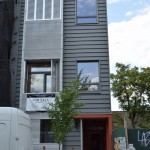 There was much excitement buzzing in Prospect Park, Brooklyn on the eve of August 5th, 2015 as Brooklyn’s Deputy Borough President, Diana Reyna, presented citations to the teams involved in the completion of the first certified net zero capable passive house in NYC. Paul Castrucci , the architect for this building, along with developer Further, Inc., and Aeon Solar were honored for their achievement.
There was much excitement buzzing in Prospect Park, Brooklyn on the eve of August 5th, 2015 as Brooklyn’s Deputy Borough President, Diana Reyna, presented citations to the teams involved in the completion of the first certified net zero capable passive house in NYC. Paul Castrucci , the architect for this building, along with developer Further, Inc., and Aeon Solar were honored for their achievement.
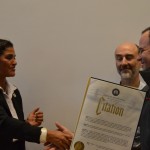 R-951 Residence is made up of three duplex 1,500 square feet condominiums that which have unique outdoor spaces and beautiful interior design, as well as, sustainable function. The building does not require fossil fuel, and natural gas to heat, cool, or light the space. The living units have their own supply of 4kW Solar Photovoltaic systems on the rooftop that acts as shading for the roof accessible areas. This feature makes it possible for the on-site panels to generate enough energy to power each unit ‘over the course of a year’, as promoted per design.
The high performance building envelope is the most important feature of this and any passive house. The walls are insulated to R-40, the windows and doors are ‘tilt and turn’ R-9 triple glazed. The envelope is sealed to 0.6 air changes per hour at 50 pascals pressure, which also creates a soundproof effect for a quiet indoor environment. Passive design includes large south-facing windows to maximize winter solar heat gain, and the metal accordion style screens provide shade during the summer season.
R-951 Residence is made up of three duplex 1,500 square feet condominiums that which have unique outdoor spaces and beautiful interior design, as well as, sustainable function. The building does not require fossil fuel, and natural gas to heat, cool, or light the space. The living units have their own supply of 4kW Solar Photovoltaic systems on the rooftop that acts as shading for the roof accessible areas. This feature makes it possible for the on-site panels to generate enough energy to power each unit ‘over the course of a year’, as promoted per design.
The high performance building envelope is the most important feature of this and any passive house. The walls are insulated to R-40, the windows and doors are ‘tilt and turn’ R-9 triple glazed. The envelope is sealed to 0.6 air changes per hour at 50 pascals pressure, which also creates a soundproof effect for a quiet indoor environment. Passive design includes large south-facing windows to maximize winter solar heat gain, and the metal accordion style screens provide shade during the summer season.
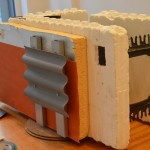
Sample of wall construction. Insulated concrete form (ICF) with additional exterior rigid board insulation for R-40 value.

